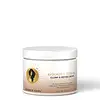What's inside
What's inside
 Key Ingredients
Key Ingredients

 Benefits
Benefits

 Concerns
Concerns

 Ingredients Side-by-side
Ingredients Side-by-side

Water
Skin ConditioningCetearyl Alcohol
EmollientPersea Gratissima Oil
Skin ConditioningCaprylic/Capric Triglyceride
MaskingAloe Barbadensis Leaf Juice
Skin ConditioningCetrimonium Chloride
AntimicrobialVp/Va Copolymer
Sorbitol
HumectantAstrocaryum Murumuru Seed Butter
EmollientArgania Spinosa Kernel Oil
EmollientButyrospermum Parkii Butter
Skin ConditioningRosa Centifolia Flower Oil
MaskingCrambe Abyssinica Seed Oil
Skin ConditioningGlycerin
HumectantHydroxyethylcellulose
Emulsion StabilisingNigella Sativa Seed Oil
EmollientTrigonella Foenum-Graecum Seed Extract
PerfumingTocopheryl Acetate
AntioxidantAdansonia Digitata Seed Oil
EmollientBehentrimonium Methosulfate
Hydroxypropyl Starch Phosphate
Phenoxyethanol
PreservativeEthylhexylglycerin
Skin ConditioningParfum
MaskingWater, Cetearyl Alcohol, Persea Gratissima Oil, Caprylic/Capric Triglyceride, Aloe Barbadensis Leaf Juice, Cetrimonium Chloride, Vp/Va Copolymer, Sorbitol, Astrocaryum Murumuru Seed Butter, Argania Spinosa Kernel Oil, Butyrospermum Parkii Butter, Rosa Centifolia Flower Oil, Crambe Abyssinica Seed Oil, Glycerin, Hydroxyethylcellulose, Nigella Sativa Seed Oil, Trigonella Foenum-Graecum Seed Extract, Tocopheryl Acetate, Adansonia Digitata Seed Oil, Behentrimonium Methosulfate, Hydroxypropyl Starch Phosphate, Phenoxyethanol, Ethylhexylglycerin, Parfum
Water
Skin ConditioningGlycerin
HumectantPolysorbate 20
EmulsifyingVp/Va Copolymer
Tocopheryl Acetate
AntioxidantHydrolyzed Silk
HumectantPanthenol
Skin ConditioningCellulose
AbsorbentSorbic Acid
PreservativePropylene Glycol
HumectantSodium Hydroxide
BufferingHydroxyethylcellulose
Emulsion StabilisingCarbomer
Emulsion StabilisingCaprylyl Glycol
EmollientStyrene/Vp Copolymer
Sodium Acetate
BufferingIsopropyl Alcohol
SolventPotassium Sorbate
PreservativeParfum
MaskingCyclotetrasiloxane
EmollientBenzyl Alcohol
PerfumingPolyquaternium-7
Phenoxyethanol
PreservativeSodium Benzoate
MaskingCI 19140
Cosmetic ColorantLimonene
PerfumingHexyl Cinnamal
PerfumingBenzyl Benzoate
AntimicrobialCitral
PerfumingLinalool
PerfumingWater, Glycerin, Polysorbate 20, Vp/Va Copolymer, Tocopheryl Acetate, Hydrolyzed Silk, Panthenol, Cellulose, Sorbic Acid, Propylene Glycol, Sodium Hydroxide, Hydroxyethylcellulose, Carbomer, Caprylyl Glycol, Styrene/Vp Copolymer, Sodium Acetate, Isopropyl Alcohol, Potassium Sorbate, Parfum, Cyclotetrasiloxane, Benzyl Alcohol, Polyquaternium-7, Phenoxyethanol, Sodium Benzoate, CI 19140, Limonene, Hexyl Cinnamal, Benzyl Benzoate, Citral, Linalool
 Reviews
Reviews

Ingredients Explained
These ingredients are found in both products.
Ingredients higher up in an ingredient list are typically present in a larger amount.
Glycerin is already naturally found in your skin. It helps moisturize and protect your skin.
A study from 2016 found glycerin to be more effective as a humectant than AHAs and hyaluronic acid.
As a humectant, it helps the skin stay hydrated by pulling moisture to your skin. The low molecular weight of glycerin allows it to pull moisture into the deeper layers of your skin.
Hydrated skin improves your skin barrier; Your skin barrier helps protect against irritants and bacteria.
Glycerin has also been found to have antimicrobial and antiviral properties. Due to these properties, glycerin is often used in wound and burn treatments.
In cosmetics, glycerin is usually derived from plants such as soybean or palm. However, it can also be sourced from animals, such as tallow or animal fat.
This ingredient is organic, colorless, odorless, and non-toxic.
Glycerin is the name for this ingredient in American English. British English uses Glycerol/Glycerine.
Learn more about GlycerinHydroxyethylcellulose is used to improve the texture of products. It is created from a chemical reaction involving ethylene oxide and alkali-cellulose. Cellulose is a sugar found in plant cell walls and help give plants structure.
This ingredient helps stabilize products by preventing ingredients from separating. It can also help thicken the texture of a product.
This ingredient can also be found in pill medicines to help our bodies digest other ingredients.
Learn more about HydroxyethylcelluloseParfum is a catch-all term for an ingredient or more that is used to give a scent to products.
Also called "fragrance", this ingredient can be a blend of hundreds of chemicals or plant oils. This means every product with "fragrance" or "parfum" in the ingredients list is a different mixture.
For instance, Habanolide is a proprietary trade name for a specific aroma chemical. When used as a fragrance ingredient in cosmetics, most aroma chemicals fall under the broad labeling category of “FRAGRANCE” or “PARFUM” according to EU and US regulations.
The term 'parfum' or 'fragrance' is not regulated in many countries. In many cases, it is up to the brand to define this term.
For instance, many brands choose to label themselves as "fragrance-free" because they are not using synthetic fragrances. However, their products may still contain ingredients such as essential oils that are considered a fragrance by INCI standards.
One example is Calendula flower extract. Calendula is an essential oil that still imparts a scent or 'fragrance'.
Depending on the blend, the ingredients in the mixture can cause allergies and sensitivities on the skin. Some ingredients that are known EU allergens include linalool and citronellol.
Parfum can also be used to mask or cover an unpleasant scent.
The bottom line is: not all fragrances/parfum/ingredients are created equally. If you are worried about fragrances, we recommend taking a closer look at an ingredient. And of course, we always recommend speaking with a professional.
Learn more about ParfumPhenoxyethanol is a preservative that has germicide, antimicrobial, and aromatic properties. Studies show that phenoxyethanol can prevent microbial growth. By itself, it has a scent that is similar to that of a rose.
It's often used in formulations along with Caprylyl Glycol to preserve the shelf life of products.
Tocopheryl Acetate is AKA Vitamin E. It is an antioxidant and protects your skin from free radicals. Free radicals damage the skin by breaking down collagen.
One study found using Tocopheryl Acetate with Vitamin C decreased the number of sunburned cells.
Tocopheryl Acetate is commonly found in both skincare and dietary supplements.
Learn more about Tocopheryl AcetateWe don't have a description for Vp/Va Copolymer yet.
Water. It's the most common cosmetic ingredient of all. You'll usually see it at the top of ingredient lists, meaning that it makes up the largest part of the product.
So why is it so popular? Water most often acts as a solvent - this means that it helps dissolve other ingredients into the formulation.
You'll also recognize water as that liquid we all need to stay alive. If you see this, drink a glass of water. Stay hydrated!
Learn more about Water